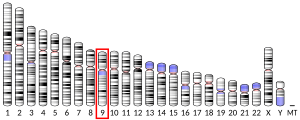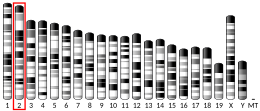Caspase recruitment domain-containing protein 9 is an adaptor protein of the CARD-CC protein family, which in humans is encoded by the CARD9 gene.[5][6] It mediates signals from pattern recognition receptors to activate pro-inflammatory and anti-inflammatory cytokines, regulating inflammation. Homozygous mutations in CARD9 are associated with defective innate immunity against yeasts, like Candida and dermatophytes.
Function
editCARD9 is a member of the CARD protein family, which is defined by the presence of a characteristic caspase-associated recruitment domain (CARD). This protein was identified by its selective association with the CARD domain of BCL10, a positive regulator and NF-κB activation.[7] It is thought to function as a molecular scaffold for the assembly of a BCL10 signaling complex that activates NF-κB. Several alternatively spliced transcript variants have been observed, but their full-length nature is not clearly defined.[6]
Clinical significance
editIn 2006, it became clear that Card9 plays important roles within the innate immune response against yeasts. Card9 mediates signals from so called pattern recognition receptors (Dectin-1) to downstream signalling pathways such as NF-κB and by this activates pro-inflammatory cytokines (TNF, IL-23, IL-6, IL-2) and an anti-inflammatory cytokine (IL-10) and subsequently an appropriate innate and adaptive immune response to clear an infection.[8] An autosomal recessive form of susceptibility to chronic mucocutaneous candidiasis was found in 2009 to be associated with homozygous mutations in CARD9.[9] Deep dermatophytosis and Card9 deficiency reported in an Iranian family led to its discovery in 17 people from Tunisian, Algerian, and Moroccan families with deep dermatophytosis.[10]
CARD9 mutations have been associated with inflammatory diseases such as ankylosing spondylitis and inflammatory bowel disease (Crohn's Disease and Ulcerative Colitis).[11] A genetic variant, c.IVS11+1G>C was found to be protective against crohn's disease, ulcerative colitis, and ankylosing spondilitis by Manuel Rivas, Mark Daly and colleagues.[12] CARD9 S12NΔ11, is a rare splice variant in which exon 11 of CARD9 is deleted. This allele, identified by deep sequencing of GWAS loci, results in a protein with a C-terminal truncation. In a functional follow-up study, using re-expressed human CARD9 isoforms in murine Card9−/− bone marrow-derived dendritic cells (BMDCs) were assessed for cytokine production. BMDCs expressing the predisposing variant CARD9 S12N showed increased TNFα and IL-6 production compared to BMDCs expressing wild-type CARD9. In contrast, CARD9 Δ11 and CARD9 S12NΔ11, as well as the C-terminal truncated variant CARD9 V6, showed significant impairment in TNFα and IL-6 production. CARD9 Δ11 was found to have a dominant negative effect on CARD9 function when co-expressed with wild-type CARD9 in human and mouse dendritic cells.[13]
References
edit- ^ a b c GRCh38: Ensembl release 89: ENSG00000187796 – Ensembl, May 2017
- ^ a b c GRCm38: Ensembl release 89: ENSMUSG00000026928 – Ensembl, May 2017
- ^ "Human PubMed Reference:". National Center for Biotechnology Information, U.S. National Library of Medicine.
- ^ "Mouse PubMed Reference:". National Center for Biotechnology Information, U.S. National Library of Medicine.
- ^ Bertin J, Guo Y, Wang L, Srinivasula SM, Jacobson MD, Poyet JL, Merriam S, Du MQ, Dyer MJ, Robison KE, DiStefano PS, Alnemri ES (Jan 2001). "CARD9 is a novel caspase recruitment domain-containing protein that interacts with BCL10/CLAP and activates NF-kappa B". J. Biol. Chem. 275 (52): 41082–6. doi:10.1074/jbc.C000726200. PMID 11053425.
- ^ a b "Entrez Gene: CARD9 caspase recruitment domain family, member 9".
- ^ Bertin J, Guo Y, Wang L, Srinivasula SM, Jacobson MD, Poyet JL, Merriam S, Du MQ, Dyer MJ, Robison KE, DiStefano PS, Alnemri ES (December 2000). "CARD9 is a novel caspase recruitment domain-containing protein that interacts with BCL10/CLAP and activates NF-kappa B". J. Biol. Chem. 275 (52): 41082–6. doi:10.1074/jbc.C000726200. PMID 11053425.
- ^ Gross O, Gewies A, Finger K, Schäfer M, Sparwasser T, Peschel C, Förster I, Ruland J (Aug 2006). "Card9 controls a non-TLR signalling pathway for innate anti-fungal immunity". Nature. 442 (7103): 651–6. Bibcode:2006Natur.442..651G. doi:10.1038/nature04926. PMID 16862125. S2CID 4405404.
- ^ Glocker EO, Hennigs A, Nabavi M, Schäffer AA, Woellner C, Salzer U, Pfeifer D, Veelken H, Warnatz K, Tahami F, Jamal S, Manguiat A, Rezaei N, Amirzargar AA, Plebani A, Hannesschläger N, Gross O, Ruland J, Grimbacher B (Oct 2009). "A homozygous CARD9 mutation in a family with susceptibility to fungal infections". N. Engl. J. Med. 361 (18): 1727–35. doi:10.1056/NEJMoa0810719. PMC 2793117. PMID 19864672.
- ^ Lanternier F, Pathan S, Vincent QB, Liu L, Cypowyj S, Prando C, Migaud M, Taibi L, Ammar-Khodja A, Boudghene Stambouli O, Guellil B, Jacobs F, Goffard JC, Schepers K, del Marmol V, Boussofara L, Denguezli M, Larif M, Bachelez H, Michel L, Lefranc G, Hay R, Jouvion G, Chretien F, Fraitag S, Bougnoux ME, Boudia M, Abel L, Lortholary O, Casanova JL, Picard C, Grimbacher B, Puel A (2013). "Deep dermatophytosis and inherited CARD9 deficiency". N Engl J Med. 369 (18): 1704–14. doi:10.1056/NEJMoa1208487. PMC 4084693. PMID 24131138.
- ^ Evans DM, Spencer CC, Pointon JJ, Su Z, Harvey D, Kochan G, et al. (August 2011). "Interaction between ERAP1 and HLA-B27 in ankylosing spondylitis implicates peptide handling in the mechanism for HLA-B27 in disease susceptibility". Nat. Genet. 43 (8): 761–7. doi:10.1038/ng.873. PMC 3640413. PMID 21743469.
- ^ Rivas MA, Beaudoin M, Gardet A, Stevens C, Sharma Y, Zhang CK, et al. (October 2011). "Deep resequencing of GWAS loci identifies independent rare variants associated with inflammatory bowel disease". Nature Genetics. 43 (11): 1066–73. doi:10.1038/ng.952. PMC 3378381. PMID 21983784.
- ^ Cao Z, Conway KL, Heath RJ, Rush JS, Leshchiner ES, Ramirez-Ortiz ZG, et al. (October 2015). "Ubiquitin Ligase TRIM62 Regulates CARD9-Mediated Anti-fungal Immunity and Intestinal Inflammation". Immunity. 43 (4): 715–26. doi:10.1016/j.immuni.2015.10.005. PMC 4672733. PMID 26488816.
External links
edit- Human CARD9 genome location and CARD9 gene details page in the UCSC Genome Browser.
Further reading
edit- Yang H, Minamishima YA, Yan Q, Schlisio S, Ebert BL, Zhang X, Zhang L, Kim WY, Olumi AF, Kaelin WG (2007). "pVHL acts as an adaptor to promote the inhibitory phosphorylation of the NF-kappaB agonist Card9 by CK2". Mol. Cell. 28 (1): 15–27. doi:10.1016/j.molcel.2007.09.010. PMC 2128776. PMID 17936701.
- Hsu YM, Zhang Y, You Y, Wang D, Li H, Duramad O, Qin XF, Dong C, Lin X (2007). "The adaptor protein CARD9 is required for innate immune responses to intracellular pathogens". Nat. Immunol. 8 (2): 198–205. doi:10.1038/ni1426. hdl:10161/11515. PMID 17187069. S2CID 20483095.
- Rual JF, Venkatesan K, Hao T, Hirozane-Kishikawa T, Dricot A, Li N, Berriz GF, Gibbons FD, Dreze M, Ayivi-Guedehoussou N, Klitgord N, Simon C, Boxem M, Milstein S, Rosenberg J, Goldberg DS, Zhang LV, Wong SL, Franklin G, Li S, Albala JS, Lim J, Fraughton C, Llamosas E, Cevik S, Bex C, Lamesch P, Sikorski RS, Vandenhaute J, Zoghbi HY, Smolyar A, Bosak S, Sequerra R, Doucette-Stamm L, Cusick ME, Hill DE, Roth FP, Vidal M (2005). "Towards a proteome-scale map of the human protein-protein interaction network". Nature. 437 (7062): 1173–8. Bibcode:2005Natur.437.1173R. doi:10.1038/nature04209. PMID 16189514. S2CID 4427026.
- Wang L, Guo Y, Huang WJ, Ke X, Poyet JL, Manji GA, Merriam S, Glucksmann MA, DiStefano PS, Alnemri ES, Bertin J (2001). "Card10 is a novel caspase recruitment domain/membrane-associated guanylate kinase family member that interacts with BCL10 and activates NF-kappa B". J. Biol. Chem. 276 (24): 21405–9. doi:10.1074/jbc.M102488200. PMID 11259443.



